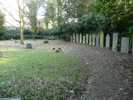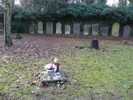Colwick Old ChurchChurchyard
 The
churchyard The
churchyard
from the west |
 The
churchyard The
churchyard
from the north |
The churchyard is now completely surrounded by a brick wall. Most of the gravestones
have been removed from their original positions and placed round the south
wall of the graveyard. The area to the south of the church has been set out
as a quiet sitting area with two seats. The north wall is very close to the
church. There is a simple ironwork entrance gate.
In 1885 when John Chaworth Musters gave the Parish more land to extend the
graveyard to the south and closer to the hall, he built a high brick wall on
the south side to separate the churchyard from the Hall grounds. A plan of
the new burial ground at Nottinghamshire Archives shows thirteen parallel rows
of gravestones in this part of the graveyard.
When a survey was made of ruined churches in Nottinghamshire in 1977 the graveyard
at Colwick was described as:
neglected, overgrown and no longer used
for burials. The graveyard is divided into two parts; the inner part defined
by a brick wall whilst the outer graveyard has lost much of its boundary wall.
A survey made by Trent Valley Archaeological Research Committee c1978
of all the gravestones in the graveyard is deposited at Nottinghamshire Archives
Office. It consists of 98 slips of paper – one for each gravestone giving
details of the type of stone, full transcription of inscriptions and a small
photograph of each stone.
| Earliest stone |
|
Babington Whatton Jun died 19 July 1713 aged 23 |
 |
| Latest stone |
|
Fanny Neale died 19 October 1963 aged 91 |
Nottinghamshire Family History Society has also recorded basic information
from 93 gravestones in its Record Series Monumental Inscriptions Vol.XX. The
last burial in the graveyard appears to be that of Thomas William Hudson who
died in 1970 aged 95 and was interred here alongside his wife who had predeceased
him.
A notable burial on the north side of the church, without gravestone, was
that of Mrs William Saville and her children, who were murdered by her
husband in Colwick Woods in 1844. The murder is noted as much for the events
at Saville’s
execution as for the murder itself. The execution took place on the steps of
the Shire Hall as usual but on this occasion a very large crowd had turned
out to see the event. As the crowd moved away after the execution, there was
a crush at the top of Garners Hill steps and many people were trampled in the
crush. Twelve people were killed and five died afterwards.
|